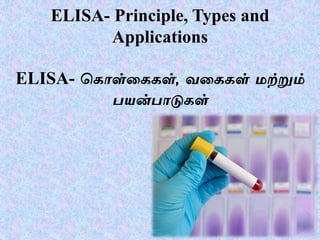ELISA
- 1. ELISA- Principle, Types and Applications ELISA- āŪāŊāŊāŪģāŊāŪāŊāŊāŪģāŊ, āŪĩāŪāŊāŊāŪģāŊ āŪŪāŪąāŊāŪąāŊāŪŪāŊ āŪŠāŪŊāŪĐāŊāŪŠāŊāŪāŊāŊāŪģāŊ
- 2. âĒ ELISA stands for Enzyme Linked Immunosorbent Assay (āŪĻ āŊāŪĪāŪŋ-āŪāŪĢāŊāŪāŊāŪāŪŠāŊāŪŠāŪāŊāŪ āŪĻ āŊāŪŊāŊ āŪĪāŪāŊāŪŠāŊāŪŠāŊāŪąāŊāŪąāŪēāŊ āŪāŪŊāŊāŪĩāŪŋ)
- 3. âĒ Immunology - āŪĪāŪāŊāŪŠāŊāŪŠāŊāŪąāŊāŪąāŪēāŪŋāŪŊāŪēāŊ; āŪĪāŪāŊāŪŠāŊāŪŠāŊāŪąāŊāŪąāŪŋāŪŊāŪēāŊ; āŪĪāŪāŊāŪŠāŊāŪŠāŊāŪĪāŊāŪĪāŪŋāŪąāŪĐāŪŋāŪŊāŪēāŊ âĒ Immune system - āŪĻ āŊāŪŊāŊ āŪāŪĪāŪŋāŪ°āŊāŪŠāŊāŪŠāŊ āŪŪāŪĢāŊāŪāŪēāŪŪāŊ;āŪĻ āŊāŪŊāŊ āŪāŪĪāŪŋāŪ°āŊāŪŠāŊāŪĪāŊ āŪĻāŪĪāŊāŪāŊāŪĪāŪŋ âĒ Antigen - āŪāŪāŪąāŊāŪāŊāŪŠāŊāŪŠāŊ āŪāŪāŊāŪāŪŋ; āŪāŪĪāŪŋāŪ°āŊāŪāŊāŪĻāŊāŪĐāŪŋ; āŪŠāŪŋāŪąāŪĻāŪŠāŊāŪ°āŊāŪĻāŊāŪĪāŪŋāŪ°āŪŋāŪŊāŊāŪāŊāŪāŪŋ; āŪāŪĪāŪŋāŪ°āŪŋāŪŊāŊāŪāŊāŪāŪŋ âĒ Antibody - āŪāŪāŪąāŊāŪāŊāŪŠāŊāŪŠāŊ āŪŪāŊāŪēāŪŪāŊ; āŪāŪĪāŪŋāŪ°āŊāŪŠāŊāŪĻāŪŠāŊāŪ°āŊāŪģāŊ; āŪŠāŪŋāŪąāŪĻāŪŠāŊāŪ°āŊāŪĻāŊāŪĪāŪŋāŪ°āŪŋ âĒ Immunity - āŪĻ āŊāŪŊāŊ āŪāŪĪāŪŋāŪ°āŊāŪŠāŊāŪŠāŊāŪĪāŊ āŪĪāŪŋāŪąāŪĐāŊ; āŪĻ āŊāŪŊāŊāŪĪāŊ āŪĪāŪāŊāŪĪāŪŋāŪąāŪĐāŊ; āŪĻ āŊāŪŊāŊāŪĪāŊ āŪĪāŪĢāŪāŪāŊ āŪāŊāŪŠāŊāŪŠāŊ
- 6. âĒ āŪāŪĩāŊāŪĻ āŊāŪ°āŊ āŪĻ āŊāŪĪāŪŋāŪŊāŪŋāŪēāŊāŪŪāŊ āŪāŪŋāŪē āŪāŊāŪąāŪŋāŪŠāŊāŪŠāŪŋāŪāŊāŪ āŪ āŪŪāŪŋāŪĻ āŊ āŪ āŪŪāŪŋāŪēāŪĪāŊ āŪĻāŪĪāŊāŪāŊāŪūāŊāŪāŪģāŊ āŪĻāŊāŊāŪūāŊāŪĻāŊāŪĪāŊ āŪĩāŪŋāŪĢ āŪŠāŪāŊāŪĻāŪŠāŊāŪ°āŊāŪģāŊ (āŪāŊāŪīāŊāŪŠāŊāŪŠāŪĢāŪ) āŪĻāŊāŪĪāŊ āŪŠāŪŋāŪĢāŊ āŪĪāŪąāŊāŪāŊ āŪāŪąāŊāŪąāŊāŪąāŊāŪĻāŪŠāŊāŪēāŊ āŪāŪ°āŊ āŪŪāŊāŪŠāŊāŪŠāŪ°āŪŋāŪŪāŊāŊ āŪ āŪĢāŪŪāŪŠāŊāŪĢāŪŠ āŪāŪ°āŊ āŊāŪāŊāŪāŊāŪāŪŋāŪĐāŊāŪą . âĒ āŪāŪĩāŊāŪĩāŪŋāŪāŪĻāŪŪ āŪāŪŊāŪāŊāŪāŪŋāŪāŪŪāŊ āŪ āŪēāŊāŪēāŪĪāŊ āŪāŪŊāŪŋāŪ°āŊāŪŠāŊāŪŠāŊ āŪĻāŪŋāŪĢāŪēāŪŊāŪŪāŊ (Active Site) āŪ āŪŠāŊāŪŠāŪāŊāŪŪāŊ. âĒ āŪāŪĪāŊ āŪĪāŊāŪĐāŊ āŪāŪ°āŊ āŪĻ āŊāŪĪāŪŋāŪŊāŪŋāŪĐāŊ āŪĪāŪĐāŪŋāŪĪāŊāŪĪāŪĐāŊāŪĢāŪŪāŪĢāŪŊ (specificity) /āŪĪāŊāŪēāŊāŪēāŪŋāŪŊāŪĪāŊāŪĪāŪĐāŊāŪĢāŪŪāŪĢāŪŊ āŪŪāŊāŪāŪŋāŪĩāŊ āŪĻāŊāŪŊāŊāŪāŪŋāŪĐāŊāŪą .
- 7. âĒ ELISA is an antigen antibody reaction âĒ It is a common laboratory technique which is usually used to measure the concentration of antibodies or antigens in blood.
- 8. âĒ ELISA āŪāŪĐāŊāŪŠāŪĪāŊ āŪŠāŪŋāŪąāŪĻāŪŠāŊāŪ°āŊāŪĻāŊāŪĪāŪŋāŪ°āŪŋāŪŊāŊāŪāŊāŪāŪŋ(Antigen) â āŪŠāŪŋāŪąāŪĻāŪŠāŊāŪ°āŊāŪĻāŊāŪĪāŪŋāŪ°āŪŋ(Antibody) āŪāŪĪāŪŋāŪ°āŊāŪĩāŪŋāŪĢ āŪāŪāŊāŪŪāŊ. âĒ āŪāŪĪāŊ āŪīāŪāŊāŪāŪŪāŊāŪ āŪāŪ°āŪĪāŊāŪĪāŪĪāŊāŪĪāŪŋāŪēāŊ āŪŠāŪŋāŪąāŪĻāŪŠāŊāŪ°āŊāŪĻāŊāŪĪāŪŋāŪ°āŪŋāŪāŪģāŊ āŪ āŪēāŊāŪēāŪĪāŊ āŪŠāŪŋāŪąāŪĻāŪŠāŊāŪ°āŊāŪĻāŊāŪĪāŪŋāŪ°āŪŋāŪŊāŊāŪāŊāŪāŪŋāŪāŪģāŪŋāŪĐāŊ āŪĻāŊāŪąāŪŋāŪĢ āŪ āŊāŪĩāŪŋāŪāŊ āŪĪāŪąāŊāŪāŊ āŪŠāŪŊāŪĐāŊāŪŠāŪāŊāŪĪāŊāŪĪāŪŠāŊāŪŠāŪāŊāŪŪāŊ āŪāŪ°āŊ āŪĻāŪŠāŊāŪĪāŊ āŊ āŪāŪŊāŊ āŪ āŪĻāŊāŪāŊāŪŠāŪŪāŊāŪāŊāŪŪāŊ.
- 9. âĒ ELISA is a plate based assay technique which is used for detecting and quantifying substances such as peptides, proteins, antibodies and hormones. âĒ ELISA āŪāŪĐāŊāŪŠāŪĪāŊ āŪāŪ°āŊ āŪĪāŪāŊāŪāŊ āŪ āŪāŪŋāŪŠāŊāŪŠāŪĢāŪāŪŊāŪŋāŪēāŊ āŪŪāŪĪāŪŋāŪŠāŊāŪŠāŊāŪāŊāŪāŊ āŪĻāŊāŪāŊāŪŠāŪŪāŊāŪāŊāŪŪāŊ, āŪāŪĪāŊ āŪĻāŪŠāŪŠāŊāŪĢāŪāŪāŊāŪļāŊ, āŪŠāŊāŪ°āŪĪāŪāŊāŪāŪģāŊ, āŪŠāŪŋāŪąāŪĻāŪŠāŊāŪ°āŊāŪĻāŊāŪĪāŪŋāŪ°āŪŋāŪāŪģāŊ āŪŪāŪąāŊāŪąāŊāŪŪāŊ āŪđāŊāŪ°āŊāŪĻāŪŪāŊāŪĐāŊāŪāŪģāŊ āŪĻāŪŠāŊāŪĐāŊāŪą āŪĻāŪŠāŊāŪ°āŊāŪāŊāŪāŪĢāŊ āŪāŪĢāŊāŪāŪąāŪŋāŪŊ āŪŪāŪąāŊāŪąāŊāŪŪāŊ āŪ āŊāŪĩāŪŋāŪāŊ āŪĪāŪąāŊāŪāŊāŪŠāŊ āŪŠāŪŊāŪĐāŊāŪŠāŪāŊāŪĪāŊāŪĪāŪŠāŊāŪŠāŪāŊāŪāŪŋāŪąāŪĪāŊ.
- 10. âĒ An enzyme conjugated with an antibody reacts with colorless substrate to generate a colored product. âĒ Such substrate is called chromogenic substrate. âĒ āŪāŪ°āŊ āŪŠāŪŋāŪąāŪĻāŪŠāŊāŪ°āŊāŪĻāŊāŪĪāŪŋāŪ°āŪŋāŪŊāŊāŪāŪĐāŊ āŪāŪĢāŊāŪĻāŊāŪĪ āŪāŪ°āŊ āŪĻ āŊāŪĪāŪŋ,āŪĻāŪŋāŪąāŪŠāŊāŪĻāŪŠāŊāŪ°āŊāŪģāŊ āŪāŪĐāŊāŪąāŪŋāŪĢ āŪāŪ°āŊ āŊāŪāŊāŪ āŪĻāŪŋāŪąāŪŪāŪąāŊāŪą āŪāŊāŪīāŊāŪŠāŊāŪŠāŪĢāŪāŪŊāŊāŪāŪĐāŊ āŪĻāŊāŪŊāŪēāŊāŪŠāŪāŊāŪāŪŋāŪąāŪĪāŊ. âĒ āŪāŪĪāŊāŪĪāŪĢāŪāŪŊ āŪāŊāŪīāŊāŪŠāŊāŪŠāŪĢāŪ, āŪāŊāŪĻāŪ°āŊāŪŪāŪĻāŊāŪĐāŪŋāŪāŊ āŪāŊāŪīāŊāŪŠāŊāŪŠāŪĢāŪ āŪ āŪ āŪĢāŪīāŪāŊāŪāŪŠāŊāŪŠāŪāŊāŪāŪŋāŪąāŪĪāŊ.
- 11. âĒ A number of enzymes have been used for ELISA such as alkaline phosphatase, horse radish peroxidase and beta galactosidase. âĒ Specific substrates such as ïķ ortho-phenyldiamine dihydrochloride (for peroxidase), ïķ paranitrophenyl phosphate (for alkaline phosphatase) are used which are hydrolysed by above enzymes to give colored end product.
- 12. Principle âĒ ELISAs are typically performed in 96-well polystyrene plates. âĒ ELISAāŪāŪģāŊ āŪĻāŪŠāŊāŪĪāŊ āŊāŪ 96 āŪĪāŊāŪĢāŊāŪāŪģāŊ āŪĻāŪāŊāŪĢāŊāŪ āŪŠāŊāŪēāŊāŪāŊāŪāŪŋāŪ°āŪŋāŪŊāŪ°āŪŋāŪĐāŊ āŪĪāŪāŪāŊāŪāŪģāŪŋāŪēāŊ āŪĻāŪŋāŪāŪīāŊāŪĪāŊāŪĪāŪŠāŊāŪŠāŪāŊāŪāŪŋāŪĐāŊāŪą . âĒ The serum is incubated in a well, and each well contains a different serum.
- 13. âĒ A positive control serum and a negative control serum would be included among the 96 samples being tested. âĒ āŪāŪ°āŊ āŪĻ āŪ°āŊāŪŪāŪĢāŪąāŪŊāŊ āŪāŪāŊāŪāŊāŪŠāŊāŪŠāŊāŪāŊāŪāŊ āŪāŊāŪ°āŪŪāŊ āŪŪāŪąāŊāŪąāŊāŪŪāŊ āŪāŪ°āŊ āŪāŪĪāŪŋāŪ°āŊāŪŪāŪĢāŪą āŪāŪāŊāŪāŊāŪŠāŊāŪŠāŊāŪāŊāŪāŊ āŪāŊāŪ°āŪŪāŊ āŪāŪāŪŋāŪŊāŪĢ 96 āŪŪāŊāŪĪāŪŋāŪ°āŪŋāŪāŪģāŪŋāŪēāŊ āŪāŪģāŊāŊāŪāŪāŊāŪāŊāŪŪāŊ. âĒ Antibodies or antigens present in serum are captured by corresponding antigen or antibody coated on to the solid surface.
- 14. âĒ After some time, the plate is washed to remove serum and unbound antibodies or antigens. âĒ To detect the bound antibodies or antigens, a secondary antibodies that are attached to an enzyme are added to each well. âĒ āŪŠāŪŋāŪĢāŊāŪāŊāŪāŪŠāŊāŪŠāŪāŊāŪ āŪŠāŪŋāŪąāŪĻāŪŠāŊāŪ°āŊāŪĻāŊāŪĪāŪŋāŪ°āŪŋāŪāŪģāŊ āŪ āŪēāŊāŪēāŪĪāŊ āŪŠāŪŋāŪąāŪĻāŪŠāŊāŪ°āŊāŪĻāŊāŪĪāŪŋāŪ°āŪŋāŪŊāŊāŪāŊāŪāŪŋāŪāŪĢāŊ āŪāŪĢāŊāŪāŪąāŪŋāŪŊ, āŪāŪ°āŊ āŪĻ āŊāŪĪāŪŋāŪāŊāŪāŊ āŪāŪĢāŊāŪāŊāŪāŪŠāŊāŪŠāŪāŊāŪāŊāŪģāŊāŊ āŪāŪ°āŪĢāŊāŪāŊāŪŪāŊ āŪĻāŪŋāŪĢāŪē āŪŠāŪŋāŪąāŪĻāŪŠāŊāŪ°āŊāŪĻāŊāŪĪāŪŋāŪ°āŪŋāŪāŪģāŊ āŪāŪĩāŊāŪĻ āŊāŪĐāŊāŪąāŪŋāŪēāŊāŪŪāŊ āŪĻāŊāŪ°āŊāŪāŊāŪāŪŠāŊāŪŠāŪāŊāŪāŪŋāŪĐāŊāŪą
- 15. âĒ After an incubation period (āŪ āŪĢāŪāŪāŊāŪāŊāŪāŊāŪŪāŊ āŪāŊāŪēāŪŪāŊ), the unbound secondary antibodies are washed off. âĒ When a suitable substrate (āŪāŊāŪīāŊāŪŠāŊāŪŠāŪĢāŪ) is added, the enzyme (āŪĻ āŊāŪĪāŪŋāŪŊāŪŪāŊ) reacts with it to produce a color. âĒ This color produced is measurable as a function or quantity of antigens or antibodies present in the given sample.
- 16. Types of ELISA âĒ Frequently there are 3 types of ELISA on the basis of binding structure between the Antibody and Antigen. ïąIndirect ELISA (āŪŪāŪąāŊāŪŪāŊāŪ ELISA) ïąSandwich ELISA (āŪāŪūāŪĢāŊāŪāŊāŪĩāŪŋāŪāŊ ELISA) ïąCompetitive ELISA (āŪŠ āŪūāŪāŊāŪāŪŋ ELISA)
- 17. Indirect ELISA (āŪŪāŪĢāŪąāŪŪāŊāŪ ELISA)
- 18. âĒ In this technique, antigen is coated on the microtiter well. âĒ Serum or some other sample containing primary antibody is added to the microtiter well and allowed to react with the coated antigen. âĒ Any free primary antibody is washed away and the bound antibody to the antigen is detected by adding an enzyme conjugated secondary antibody that binds to the primary antibody.
- 19. âĒ Unbound secondary antibody is then washed away and a specific substrate for the enzyme is added. âĒ Enzyme hydrolyzes the substrate to form colored products. âĒ The amount of colored end product is measured by spectrophotometric plate readers that can measure the absorbance of all the wells of 96-well plate.
- 21. âĒ In this technique, antibody is coated on the microtiter well. âĒ A sample containing antigen is added to the well and allowed to react with the antibody attached to the well. âĒ After the well is washed, a second enzyme- linked antibody is allowed to react with the bound antigen.
- 22. âĒ Then after unbound secondary antibody (āŪāŪ°āŪĢāŊāŪāŊāŪŪāŊāŪĻāŪŋāŪĢāŪē āŪŠāŪŋāŪąāŪĻāŪŠāŊāŪ°āŊāŪĻāŊāŪĪāŪŋāŪ°āŪŋ) is removed by washing. âĒ Finally substrate (āŪāŊāŪīāŊāŪŠāŊāŪŠāŪĢāŪ) is added to the plate which is hydrolyzed(āŪĻāŊāŪ°āŊāŪŠāŊāŪŠāŪāŊāŪŠāŊāŪŠāŊ) by enzyme to form colored products.
- 23. Competitive ELISA (āŪĻāŪŠāŊāŪāŊāŪāŪŋ ELISA) âĒ Antibody (āŪŠāŪŋāŪąāŪĻāŪŠāŊāŪ°āŊāŪĻāŊāŪĪāŪŋāŪ°āŪŋ) is first incubated in solution with a sample containing antigen (āŪŠāŪŋāŪąāŪĻāŪŠāŊāŪ°āŊāŪĻāŊāŪĪāŪŋāŪ°āŪŋāŪŊāŊāŪāŊāŪāŪŋ) âĒ The antigen-antibody (āŪŠāŪŋāŪąāŪĻāŪŠāŊāŪ°āŊāŪĻāŊāŪĪāŪŋāŪ°āŪŋāŪŊāŊāŪāŊāŪāŪŋ - āŪŠāŪŋāŪąāŪĻāŪŠāŊāŪ°āŊāŪĻāŊāŪĪāŪŋāŪ°āŪŋ )mixture is then added to the microtitre we which is coated with antigen.
- 24. âĒ The more the antigen present in the sample, the less free antibody will be available to bind to the antigen- coated well. âĒ āŪŠāŪŋāŪąāŪĻāŪŠāŊāŪ°āŊāŪĻāŊāŪĪāŪŋāŪ°āŪŋāŪŊāŊāŪāŊāŪāŪŋāŪāŪģāŊ āŪ āŊāŪĩāŊ āŪ āŪĪāŪŋāŪāŪŪāŊāŪ āŪāŊāŊāŪŠāŊāŪŠāŪāŊāŪŪāŊ āŪĻāŪŠāŊāŪĪāŊ ,āŪ āŪąāŊāŪąāŊāŪāŪĐāŊ āŪāŪĢāŊāŪŊāŊāŪĪ āŪŠāŪŋāŪą āŪĻāŪŠāŊāŪ°āŊāŪģāŊ āŪāŪĪāŪŋāŪ°āŪŋāŪāŪģāŪŋāŪĐāŊ āŪ āŊāŪĩāŊ āŪāŊāŪĢāŪą āŊāŪ āŪāŊāŊāŪŠāŊāŪŠāŪāŊāŪŪāŊ âĒ After the well is washed, enzyme conjugated secondary antibody specific the primary antibody is added to determine the amount of primary antibody bound to the well. âĒ For competitive ELISA, the higher the sample antigen concentration, the weaker the eventual signal.
- 26. Application âĒ Presence of antigen or the presence of antibody in a sample can be evaluated. âĒ Determination of serum (āŪāŊāŪ°āŊāŪĪāŪŋāŪĻāŊāŪ°āŊāŪŠāŊāŪŠāŊāŪŊāŪŪāŊ) antibody concentrations in a virus test. âĒ Used in food industry when detecting potential food allergens . âĒ Applied in disease outbreaks- tracking the spread of disease e.g. HIV, bird flu, common, colds, cholera, STD etc.























































